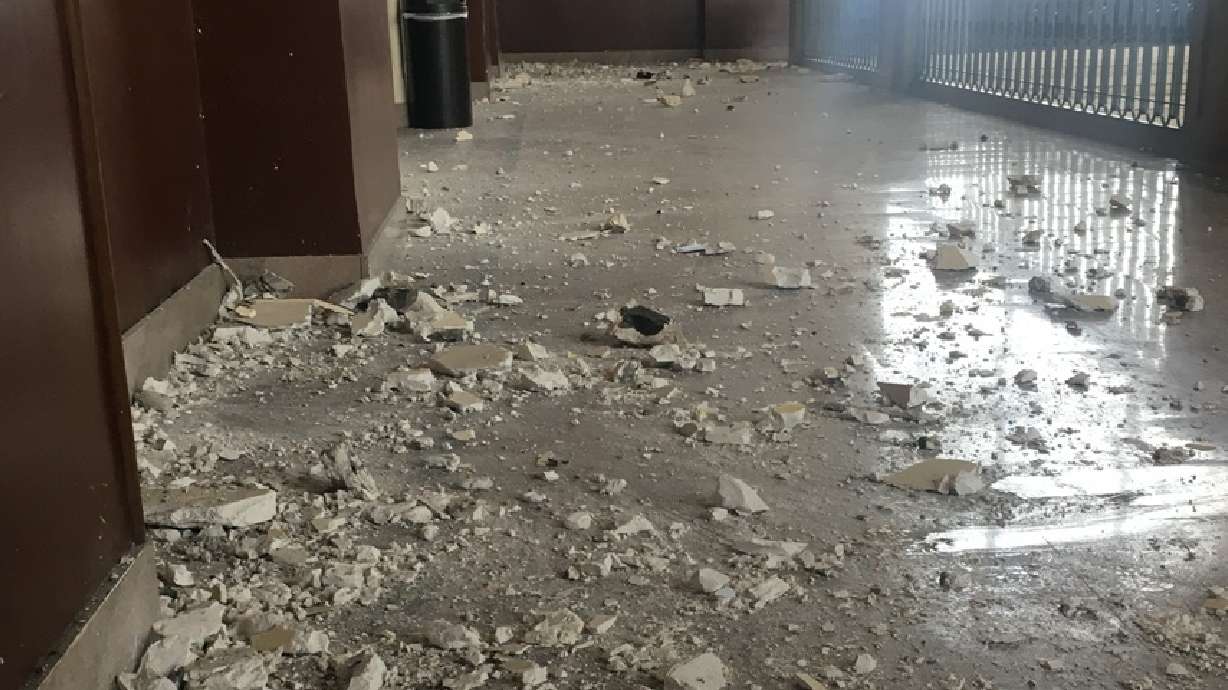Estimated read time: 4-5 minutes
This archived news story is available only for your personal, non-commercial use. Information in the story may be outdated or superseded by additional information. Reading or replaying the story in its archived form does not constitute a republication of the story.
SALT LAKE CITY — Utah’s prized historic possessions are believed to be OK following Wednesday’s 5.7 magnitude earthquake that rattled the Wasatch Front and also created damage to the Rio Grande building severe enough that its structural integrity was still being evaluated Thursday.
That said, the quake and dozens of subsequent aftershocks, as well as two other earthquakes that registered 4.6 magnitude Wednesday, may have bolstered the idea to move the Utah State Historical Archives elsewhere. A good portion of the archived items — which range in everything from the first Utah State flag to a pocket watch owned by a worker killed in the Scofield Mine Disaster to artifacts from the Topaz War Relocation Center — are stored in the basement of the Rio Grande.
Some artifacts in the basement were knocked off walls and shelves; a generator was used to keep nitrate photographs stored in a refrigerator stay cool, said Utah Department of Heritage & Arts spokesman Josh Loftin. There was also some damage to the state's art collection facility, which is stored in a separate building nearby. Loftin said the shelves that hold paintings and other artwork "dominoed" by collapsing on itself.
"Most of the art seems to be OK because they all kind of just fell on top of each other," he said. "That definitely reinforced that we need to get this stuff into a place that is going to be more secure to protect these historic artifacts and the fine art that we have."

The department began seeking a new facility to store the historic items a few years ago because they were being stored in a basement without adequate temperature control and underneath the building’s pipes; a new building for the archives is planned in the coming years. In 2018, officials said the Rio Grande building wasn’t prepared for a major earthquake. Wednesday’s earthquake was the largest to hit Utah in nearly three decades, but experts say it wasn’t "The Big One."
It did, however, create sprinkler damage at Salt Lake City International Airport. State historians are thankful the pipes in the Rio Grande building remained firm, which likely spared the archives from significant damage.
"Where we got really lucky with the artifacts is the sprinklers did not go off. There was no significant debris that came down in the basement to break or damage any of those artifacts," Loftin said. "Most importantly, it wasn’t strong enough to cause any sort of collapse."
That’s not to say the building went unscathed. When Loftin entered it Wednesday morning, he came across chunks of plaster that had fallen onto its second-floor mezzanine. Plaster had also fallen onto its stairwells, and some of the offices in the building had some cracks in them. There was no significant damage to the basement.
This is an inside look at the #RioGrandeDepot... major damage inside in the mezzanine area... Security staff went through and shared this video. Safety inspectors say no entry until further notice... @KSL5TV#UtahEarthquake 🎥 court: Brett Bell pic.twitter.com/1ICfcL3HBE
— Garna Mejia KSL (@GarnaMejiaKSL) March 18, 2020
"In the main display, we had multiple failures of the upper façade and a lot of cracks in the plaster," Thomas Peterson, with the Utah State Division of Facilities Construction and Management, told KSL on Wednesday.
State engineers began accessing the damage after the earthquake, and the building was evacuated as a precaution. Loftin said they weren’t sure if the damage was superficial or structural. Ironically, the building was due to undergo a seismic study soon.
"They were very optimistic that it was just superficial, that it was just some plaster damage and nothing that would cause the building to come down," he said. "We’re optimistic we’ll be back in there."
As for the future of the state archives, there is a plan in place for a new facility at Capitol Hill thanks to funding received during the past two legislative sessions. The state’s office building, which stands north of the Utah Capitol, is scheduled to be torn down this year and the new archives building will be built in that place, Loftin explained. The new facility will allow people to view the state’s archive items better than what the Rio Grande can offer now.
The new building is expected to be completed by about 2023, but Loftin wasn’t sure if the recent economic downturn related to COVID-19 concerns will affect the construction timetable. That facility, when completed, will also be equipped to handle a larger earthquake.
"It’ll have all the necessary climate controls and it won’t be trying to retrofit a building that is ill-suited for the purpose it’s being used for," Loftin said.
The hope is that there won’t be another natural disaster that could compromise the archives between now and then.









